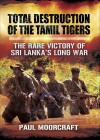Total Destruction of the Tamil Tigers
Written by: Paul Moorcraft,
Pen and Sword Publishing, 2013,
ISBN 9781781591536, 184pp
Reviewed by: Major Chris Buckham
Dr Moorcraft has written a very enlightening book about a war that received, relatively speaking, little to no coverage in the West; nor has it been the subject of much post-war attention. The conflict between the minority Tamils of northern Sri Lanka and the majority Sinhalese lasted 26 years from 1983 until 2009. A mixture of asymmetric and conventional fighting, it was unique in that funding for the rebels came primarily from the Tamil diaspora and they were able to build a force that included structured and disciplined air, sea and land elements. It was also unique in that, for a majority of the conflict, the Tamils enjoyed the upper hand, only to be utterly crushed by the government following a final and incredibly violent three-year campaign known as Eelam War IV (2006–2009).
Moorcraft’s book provides detailed historical analysis of the causes and execution of the war over the entire period of the conflict. Particular attention is paid to the development and expansion of the war from both the Tamil and government perspectives. This is important because it provides context to the reader and goes a long way to explaining the success of the Liberation Tigers of Tamil Eelam (LTTE) and the government’s struggle to defeat them. Moorcraft also discusses the key international players and the impact of the international environment on the struggle; in this case, the main external influence came from India.
This latter point is interesting as the traditional players, the United States, United Kingdom and Russia, had very little influence on activities in Sri Lanka. While the Sinhalese government paid lip service to the suggestions of international bystanders, it was well aware that it had to respond to pressure from India, the local superpower. Moorcraft clearly identifies and deftly analyses the impact of Indian intervention on the conflict and the complexity of that relationship (with both sides). He also explains the convoluted role of the Indian peacekeeping force in its efforts to influence the final outcome and the lessons learned by the Tamils (and the Indians) from that interaction.
The development of capacity at each doctrinal level (tactical, operational and strategic) by the two sides is also investigated and described in this account. This aspect is quite fascinating as the Tigers represented a unique non-traditional force that became increasingly more effective because of its flexibility and adaptability and also due to the fact that it remained under the sole direction of an acknowledged military genius (Tigers’ leader, Prabhakaran). The Sri Lankan forces, hamstrung by changing governments, a concerted effort to keep their own forces weak and a lack of cooperation between the elements, struggled until they, too, were finally able to coordinate and focus their efforts in the penultimate war of 2006–2009 in which they achieved total victory. The Tigers, despite early and protracted successes, were unable and unwilling to transfer their military success into an effective negotiated and political settlement. Combined with a series of strategic blunders such as the assassination of Indian Prime Minister Rajiv Ghandi and the use of ‘mafia’-style techniques to ensure funding from the diaspora, the Tigers ultimately provided their adversaries common cause and isolated themselves internationally.
Moorcraft’s work provides many lessons for the professional military officer and amateur enthusiast alike. These include:
- the challenges of conducting a combination of conventional and asymmetric warfare simultaneously
- the strengths and weaknesses of domestic and autocratic government in conducting long-term operations
- the impact of the international community on outcomes (ie the 9/11 attack)
- small unit conventional and special forces tactics
- the requirement to maintain the vision and goal of operations and the critical necessity of understanding when to focus on political vice military methods
Overall, Total Destruction of the Tamil Tigers is an excellent book and is both engaging and entertaining. The production quality of the book is very high and the text easy to read. Moorcraft has also provided a detailed bibliography with copious footnotes. I thoroughly enjoyed this book and strongly recommend it to those seeking to expand their knowledge of operations in the Far East.

